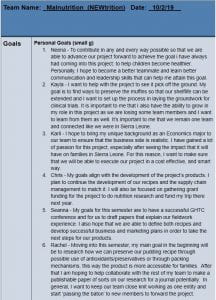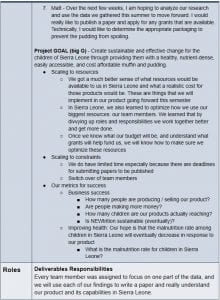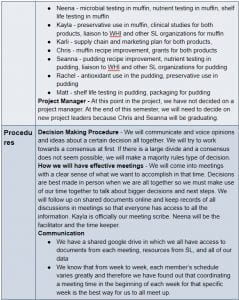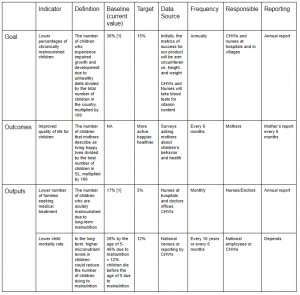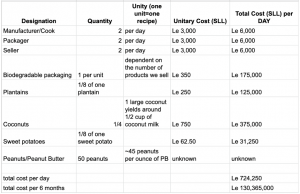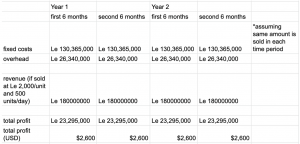PART I
Partners in our Venture:
- World Hope
- We worked at World Hope and with their staff.
- They helped us because they provided us with workspace and connections in Sierra Leone. We helped them too because we expanded their reputation by involving them and tying them to our research.
- We should continue to participate in important projects so that we can continue our relationship with them.
- Betteh Bakery
- They allowed us to use their spaces for baking the muffins and roasting the sweet potatoes
- We helped them develop their business model and they gave us access to resources we needed. We attempted to make it an equal relationship but there were some kinks that we needed to work out.
- It would have been a stronger relationship if they were further along in their business and we were able to fully rely on them for the things that they said we could rely on them for.
- Wesleyan Church
- We were able to establish this partnership through our relationship with the Betteh Bakery. Betteh Bakery is owned by the Wesleyan Church.
- They allowed us to use their church as a platform to administer our questionnaires. They provided us with tables, chairs, and volunteers who helped us effectively gather data. We helped the church by helping them with their core goal: helping the people of Sierra Leone.
- To strengthen this relationship, we should be sure to keep communications strong even when we are not in Sierra Leone.
- Allieu Bangura, Director of Nutrition at World Hope International
- Partnered to help us drive our project ideas, connect us with Director of Food & Nutrition, and to give us general guidance in the first stages of our project
- Introducing nutritious product for them
- More communication
- Partnered to help us drive our project ideas, connect us with Director of Food & Nutrition, and to give us general guidance in the first stages of our project
- Clinics/CHOs
- Our partnership with clinics and CHOs allowed us to gather data from mothers and children.
- The clinics allowed us to come and receive data from mothers and children. The mothers and children got to taste our food.
- This relationship was very beneficial. In order to make it more equitable and stronger we would need to bring enough food for everyone.
- University of Freetown
- Students from the university who interned at World Hope were able to help us with whatever we needed for our project.
- We gave their students real life experience in their fields that they were interested in and they helped us further our project. We worked together nicely but it was not necessarily equitable; we are students in charge of other students.
- This partnership would have been strengthened if we were positioned in closer locations.
- College of Engineering (funding partner)
- The college of engineering gave us funding to conduct our research in SL this summer.
- To strengthen this relationship we can write a publication to bring publicity to the university and the college.
- GELH (funding partner)
- GELH funded $1000 for each of us to travel to Sierra Leone.
- GELH helped us by making it financially feasible for us to go. We help them because we are giving them a good reputation and helping them contribute.
- It will be a stronger relationship after we do the GELH presentation at the end of October; they will know exactly what we did and how they helped us.
- Creative Inquiry Dept
- The Creative Inquiry Department gave us funding for in country expenses
- We gave them publicity for the project by coming back and producing projects
- We can make the relationship better by continuing to advocate and recruit new GSIF members
- Health Ministry of Sierra Leone
-
- Aminata Shamit Koroma- the Director of Food and Nutrition at the Ministry of Health in Sierra Leone is the originator of the project
- We would like general/official approval of our products from the Ministry of Health. If we hope to distribute our product in hospitals in the future, we will need a strong relationship with the Ministry of Health in order to gain necessary approvals as well.
- This partnership still needs to be established in order to see how each of us can benefit one another, but we could help the Ministry of Health by expanding the number of affordable foods that can be used to fight malnutrition and stunting.
PART II
Ultimate Outcome that we want to see:
- Elimination or minimization of micronutrient deficiencies/malnutrition in children in Sierra Leone.
How to build a larger movement to get to this cause:
- Build a coalition
- Diverse group of individuals and organizations who work together to reach a common goal
OUR COALITION
Ultimate Goal: Elimination or minimization of micronutrient deficiencies/malnutrition in children in Sierra Leone.
Name: NewTrition Coalition
People:
- Sierra Leone President
- Why the relationship is critical: approval of the products and support for marketing and distribution purpose
- Sierra Leone Honorables
- Why the relationship is critical: support for marketing and distribution purpose
- Director of Food & Nutrition, Aminata Shamit Koroma
- Why the relationship is critical: brains behind the project, so we would like her approval of the products we create
- Ministry of Health and Sanitation
- Why the relationship is critical: potentially need to approve the products we create in the future
- WHI
- Why the relationship is critical: help us build relationships with officials, companies, and mothers in Sierra Leone and give us credibility; can help us secure funding and approvals
- UNICEF
- Why the relationship is critical: Help advance the project on a more national level with a lot of power backing it; connects us to other organizations, such as the mother support group part of UNICEF, listed below.
- Mother Support Groups
- Why the relationship is critical: garners support of Mothers in the communities which would let potential customers trust us and our product.
- Soccer Player
- Why the relationship is critical: Help gather attention to the product by showing support to different groups of people, perhaps fathers, that tend to love soccer playing in their past time.
- Sierra Leone Standards Bureau
- Why the relationship is critical: Gives our product credibility and validity.
How will these organizations help us get these products? (shown in critical reasons)
What do the partners gain from being a part of the coalition?
Most notably, these partners all help forward the goal of minimizing and eliminating childhood malnutrition and stunting. More community focused members, like the Mothers Support Groups, President, Honorables, and the Director of Food & Nutrition, all want Sierra Leone children to have better, long qualities of life and get that as the product succeeds with their support. More global, national, or generally establish contributors help advance a global image of lowering childhood malnutrition and add credibility to their organizations for advancing impactful ventures.
